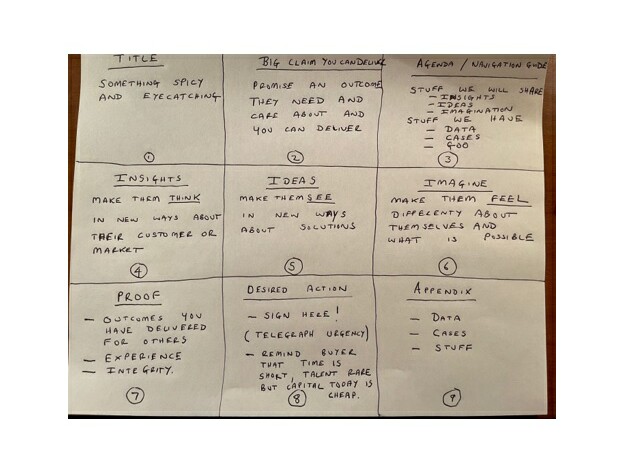Re-Thinking Presentations

As we re-imagine the future of work without an office as its center of gravity, we may also want to question why we spend so much time developing and presenting decks.
A case can be made that most presentation decks are:
- Un-necessary
- Too long
- A celebration of process versus product
- A mechanism of management control
- A waste of talent, time and treasure
- A placebo pill for what can be cured with a conversation
It may be time to re-think presentation decks.
If the meeting is central to the vocabulary of work, the presentation is often the alphabet.
Remember the office where we would spend times in meetings? We really were not in meetings but in “stare-athons” where we all gathered around a table and stared at a projected image on a central screen where the slides accompanied by the drone of a series of presenters slowly crawled forward. To distract ourselves from this slideware we would stare at the laptop or tablet in front of us or on the mobile phone discretely lodged somewhere.
The deck we were subjected too had probably gone through many revisions because of being hoisted up and down an organization with different “interested parties” fine-tuning the words, calibrating tone and working on nuance to create a hollow collection of buzz-word bingo of style without substance, points without perspective, platitudes without provocation and paths without a place to get to.
The presentation often became the point.
The process became the goal.
The communication vehicle became the destination.
Why the need for a deck?
At Amazon legend has it there are no PowerPoints at key meetings. Rather, a Word document well written and reasoned is distributed and read by everybody at the meeting. Then a real meeting which involves discussion and interrogation of the material takes place. Everybody has the same information and reading the information is far more time effective than being paraded through a few words or charts slowly flashed in sequence.
In many cases even this well-crafted Word document may not be needed and could lead to as much pre-machination and massaging as a PowerPoint deck.
Next time we ask for a deck or are asked to write a deck maybe we should start by asking why?
Often there are real reasons and needs to pull together a deck from a business pitch to a strategic plan, but often it is a lame substitute for a conversation, a mechanism to delay decisions, a way to extract information from a supplier or partner for free or just the way to “make work” or pretend to work. How much of your time is spent preparing or reviewing decks?
So, let us ask:
- What are we trying to achieve or communicate?
- Is a deck the best way of doing so? Or can we have a conversation, have a meeting without a deck, or send an e-mail?
- If it is, how can we distill it down to key points and minimize the time spent on putting it together?
Why most decks should be no longer than nine slides.
Think of all the presentations you have sat through or produced. Many were fifty, sixty or hundred slides long. How many slides do you remember? How many stood out or made a difference?
Presentations are often un-necessarily long because:
- We often confuse volume with quality.
- Many people feel without a huge deck they cannot justify their expenses or point of view.
- Often firms are paid by time exerted so they are incentivized to bloat and be baroque.
- We often focus on how the colon works versus showing the cool shit by spending too much time about the process, the background, the history, the tools, the sources of data versus delivering the idea, insight, innovation or imagination.
If we need more than nine slides to tell our story, sell our point of view, or close a deal, we may not have anything truly convincing, differentiated or interesting.
Over the years here is some learning gleaned from the best storytellers, salespeople and communicators reduced to a simple exercise:
The best presentations are ones where you write the deck but never present or share it.
Begin with a letter-size sheet of paper and a pen or pencil.
Place the sheet so it is in landscape mode.
Pretend you are playing tic tac toe and draw two vertical and two horizontal lines.
You now are looking at a slide view of nine slides on a single piece of paper.
Slide 9 is the Appendix slide where you will list supporting material and will be the last slide you fill in.
Slide 8 is the Desired Action slide which highlights what you want to get from the meeting / have the person you are presenting to act on. (This is the first slide that you fill in since this is what the point of the meeting you are having is.)
Then the focus of your work is slides 4, 5 and 6, which you may want to label Insights, Ideas and Imagination. What insights about customer, consumer, marketplace and/or competition will you be sharing that get your audience to think differently? What one, two or three big ideas are you delivering that will make their customers or consumers see them differently? What provocations, perspectives and/or points of view are you communicating that will get your audience to feel differently about their business, their future or you?
The goal of slides 4, 5 and 6 is to make sure you get the action you are looking for on slide 8.
Slide 7 is the proof of why you or your firm should be believed, and this is where you show or share the cool results you have driven for other people.
Now you are ready to write the opening slides 1, 2 and 3, which are very key. Slide 1 should be a title that will make your audience come to attention, slide 2 a promise or some other benefit or outcome you will drive (e.g. your firm will generate 20 percent improvement or x or y) and then slide 3 which is the agenda slide or navigation slide which notes that you will be sharing ideas, insights, imagination and supporting material, but are ready to jump into any section based on what your audience is interested in first or how you have read the room at the beginning.
Finally, slide 9 is the appendix of all the supporting material that the first 8 slides are built on and can include data, cases and other stuff.
Once you write this out you will find that you can make the entire presentation often without the presentation and at minimum you no longer have a long ponderous deck.
Instead, we have perspectives, provocations, points of view, insights, ideas, imagination, promises of delivery and a warehouse of stuff they can rummage through, assuming they are interested.
Try this approach. It works both as a way of doing but more importantly as a way of getting points across, telling stories, making a sale and differentiating from others.
Drawing at top by Rishad Tobaccowala.
Click the social buttons to share this content with your friends and colleagues.
The opinions and points of view expressed in this content are exclusively the views of the author and/or subject(s) and do not necessarily represent the views of MediaVillage.com/MyersBizNet, Inc. management or associated writers.


